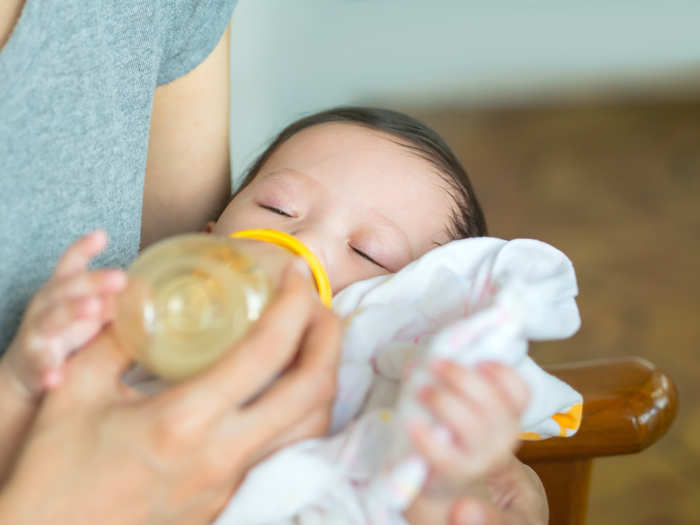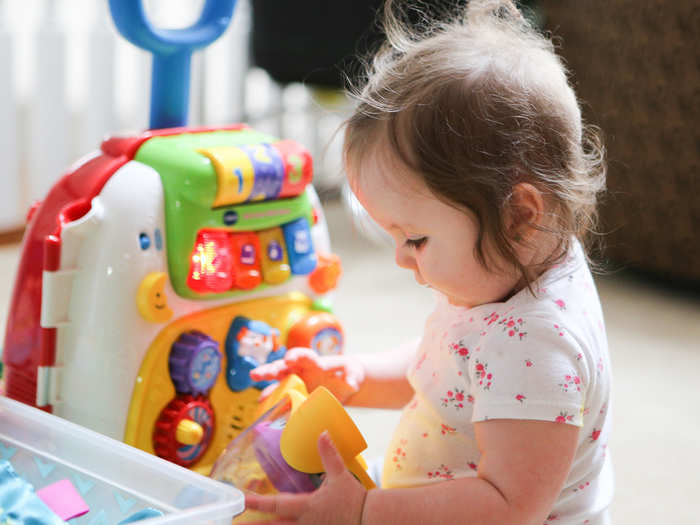- Home
- slideshows
- miscellaneous
- Breast milk could carry harmful chemicals like flame retardants and BPA, but breastfeeding is still the healthiest food source for babies
Breast milk could carry harmful chemicals like flame retardants and BPA, but breastfeeding is still the healthiest food source for babies
Flame retardants in mattresses and sofas can leach into breast milk.

Babies can ingest Bisphenol A (BPA) through breast milk, but they're likely to ingest higher doses from canned food or plastic containers.

Most of the world's population has had some exposure to bisphenol A (BPA), a chemical commonly found in plastics such as water bottles, food packaging, and paper receipts.
Numerous scientists have uncovered links between BPA and obesity, coronary artery disease, increased blood pressure, and issues with female reproductive development. BPA is also thought to inhibit lactation in breastfeeding mothers, but it only poses a small risk to infants.
Though several studies have detected BPA in mothers' breast milk, studies have shown that the chemical doesn't accumulate in the body. In fact, babies are likely to ingest higher doses of BPA from canned food or plastic containers (US manufacturers are now banned from using BPA in baby bottles).
Concentrations of pesticides in breast milk may decrease over time.

Scientists are still figuring out the link between pesticides and human disease, but studies have indicated that exposure to certain pesticides may cause cancers like leukemia and non-Hodgkin lymphoma. Pesticides have also been linked to autism risk in infants and attention deficit hyperactivity disorder (ADHD) in children and young teens.
Though many women in developing countries like Costa Rica and Zimbabwe are exposed to pesticides through agricultural work, a 2016 study published in the journal Nature found that the concentrations of pesticides in breast milk "decreased significantly" over time. The study also found that no significant relationship between an infant's pesticide exposure through breastfeeding and their height, weight, or body fat.
For now, the evidence doesn't suggest that infants will experience adverse health effects from consuming pesticides through breast milk. But the CDC has yet to determine how much pesticide exposure is safe for breastfeeding.
Phthalates are banned from children's products in the US, but they're still found in detergents and shampoos.

Phthalates are part of the plasticizer family, a class of substances that make plastic durable and flexible. Although Congress instituted a federal ban on phthalates in toys and children's products in 2008, the chemicals are still found in items like vinyl flooring, shower curtains, detergents, and shampoos.
A 2006 study found that exposure to phthalates through breast milk may affect the reproductive hormones of three-month-old boys. The authors note, however, that the effects were "subtle" and shouldn't be used as a case against breastfeeding, especially since phthalates are found in other nutrition sources such as formula.
A 2011 study published in Environment International also determined that an infant's exposure to phthalates from breast milk isn't likely to pose a significant health risk, but further research is needed to determine how widespread this exposure may be.
Low amounts of volatile organic compounds (VOCs) can be passed through breastfeeding, but indoor air is a much bigger threat.

Volatile organic compounds (VOCs) can be released by burning plastic or wood, but they're also emitted by thousands of consumer products. The chemical class has been linked to cancer and liver, kidney, and nervous system damage, though the health effects vary depending on the chemical in question.
Common types of VOCs include benzene, a known carcinogen found in plastics and cigarette smoke, and formaldehyde, a colorless gas that helps keep clothes free of wrinkles, static, and stains.
In 2007, researchers from the Johns Hopkins School of Public Health determined that infant exposure to VOCs through breast milk was relatively low. Their study found that infants ingested up to 135 times more VOCs through indoor air than through breastfeeding.
By the time a mother with heavy metals in her blood starts breastfeeding, the infant has probably been exposed in the womb.

The EPA has acknowledged the presence of heavy metals such as mercury, lead, and arsenic in breast milk. Though there is no safe amount of lead, the CDC recommends that mothers that test for blood lead levels below 40 micrograms per deciliter still breastfeed, if possible. Lead levels above this threshold aren't common, but can be found among people who work in the battery manufacturing or lead mining industries.
The EPA has found that inorganic mercury (the type most often found in breast milk) is "not well absorbed by infants" and multiple studies have found that it doesn't pose a health risk when consumed through breastfeeding. There's also evidence that arsenic is only transmitted in very low levels through breast milk.
By the time a mother with toxic metals in her blood starts breastfeeding, it's likely that the infant will have already been exposed in the womb. According to a 2015 study in the Journal of Pediatric and Neonatal Individualized Medicine, "most of the damage is already done by the time the infant is born."
Researchers found PFAS in breast milk in at least 19 countries.

Per- and polyfluoroalkyl substance (PFAS) are a class of chemicals linked to cancer, liver damage, thyroid disease, and developmental issues. The chemicals became popular in the US around the 1940s, when manufacturing companies realized they resist heat, grease, stains, and water.
Since then, scientists have discovered that PFAS can linger in water and air for thousands of years, landing them the nickname "forever chemicals." Consuming or inhaling them means they could stay in the body for life.
A 2015 study from the Harvard School of Public Health found that breastfeeding is "an important exposure pathway" for PFAS in infants. According to the researchers, an infant's PFAS concentrations can increase up to 30% for every month that they're breastfed.
Another study, published in 2018, detected breast milk with PFAS among sample populations in at least 19 countries.
Despite the presence of pollutants in breast milk, the overwhelming scientific consensus is that breastfeeding is still the healthiest food source for infants.

In fact, years of research suggests that breastfeeding can help babies fight off health problems associated with environmental chemicals, including allergies, obesity, and various forms of disease.
Popular Right Now
Popular Keywords
Advertisement